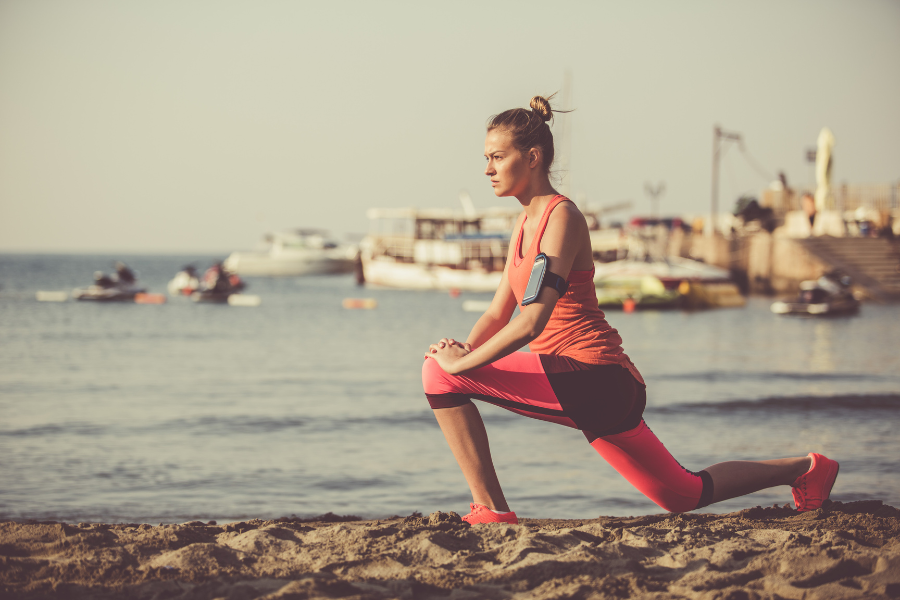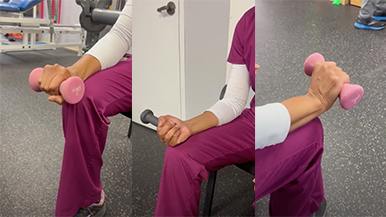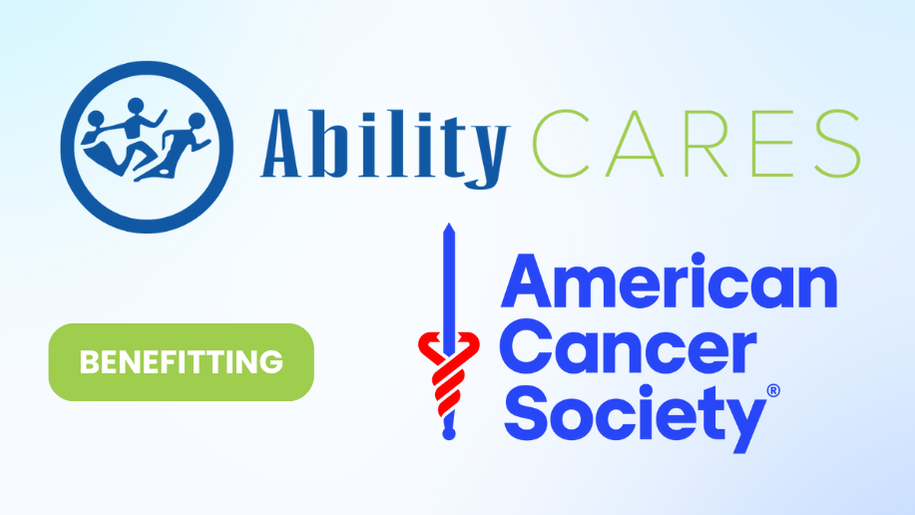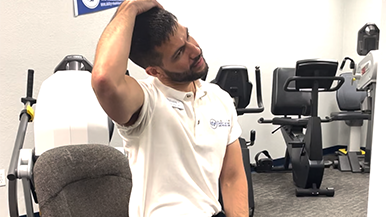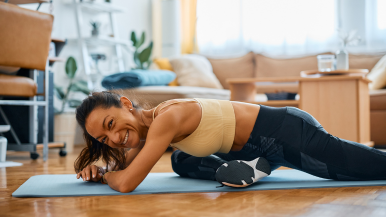
- What are Hip Flexors?
- Do Tight Hip Flexors Cause Pain?
- Benefits of Stretching Your Hip Flexors
- How to Stretch Hip Flexors Safely
- 5 Stretches to Do for Tight Hip Flexors
Do you ever experience discomfort or tightness in your hips? You’re not alone. Hip flexor tightness is extremely common, especially among active individuals and desk workers. Some estimates suggest it affects up to 90% of the population. This tightness can lead to lower back pain, neck and back stiffness, and even glute discomfort.
Whether you live a sedentary lifestyle or engage in regular physical activity, prolonged periods of sitting or exercise can contribute to tight hips. That’s why it’s important to know what hip flexors are and why stretching them is important.
At Ability Rehabilitation, we understand the significance of flexibility and mobility in your daily life. Learning how to properly stretch your hip flexors and release tension in the muscles of the hips and upper thighs can promote proper movement and usage of this region, potentially preventing injuries.
What are Hip Flexors?
The hip flexors comprise a collection of muscles along the front of your upper thigh. This group includes the iliacus, psoas major, rectus femoris, and sartorius muscles.
Among these, the iliacus and psoas major function as the primary hip flexors, collaborating to flex and stabilize your hip joint while bringing your thigh and torso closer together during activities such as walking, running, sitting, or standing. Additionally, the rectus femoris assists in hip flexion and knee extension, while the sartorius aids in hip flexion, external rotation, and knee flexion.
 Do Tight Hip Flexors Cause Pain?
Do Tight Hip Flexors Cause Pain?
Given that the hips serve as a pivotal connection between the lower back and the legs, tightness in the hip flexors can impede proper pelvic rotation, potentially affecting various body regions.
Common indicators of tight hip flexors include discomfort or pain in the front of the hip, particularly exacerbated by prolonged sitting or repetitive movements involving hip flexion, such as running and cycling.
Benefits of Stretching Your Hip Flexors
While the research doesn’t conclusively confirm whether stretching can prevent injuries, its significance should be noticed. Stretching and flexibility training offers numerous benefits beyond injury prevention.
Consistent stretching enhances joint range of motion and flexibility, improving coordination and balance. These factors are vital in maintaining mobility and reducing the risk of falls, particularly as individuals age. Moreover, regular stretching can enhance posture and alleviate discomfort.
Furthermore, stretching promotes circulation by stimulating blood flow to the muscles. This process aids in eliminating waste from muscle tissue and can accelerate recovery following muscle injuries.
How to Stretch Hip Flexors Safely
Despite the widespread understanding of the importance of stretching to alleviate tightness or soreness in muscles and hip flexors from prolonged sitting, it’s an overlooked step. To enhance flexibility and range of motion and maximize the effectiveness of workouts—especially those heavily involving the lower body and requiring significant flexibility—it’s crucial to prioritize stretching the hip flexors and related muscle groups.
The American College of Sports Medicine recommends stretching into your routine 2–3 times per week. It’s advisable to gradually increase the frequency of hip flexor stretches, aiming for daily practice to acclimate your body to the new movement patterns and reduce the risk of injury.
Hold each stretch for approximately 15 to 30 seconds during stretching sessions, repeating 2 to 4 times. However, it’s essential to listen to your body and avoid pushing through pain. If these hip flexor stretches cause discomfort or exacerbate existing injuries, seeking guidance from a physical therapist or healthcare professional for personalized care and alternative approaches is advisable.
You can integrate four stretches into your daily routine to enhance flexibility and mobility in your hip flexors. Hold each stretch for 30 seconds on each side for optimal results, and aim to complete three sets at least twice a day.
5 Stretches to Do for Tight Hip Flexors
1. Half-kneeling Hip Flexor Stretch
- Start by kneeling on the floor with your left knee down.
- Bring your right leg forward so that your right thigh is parallel to the floor, with your knee bent at a 90-degree angle and your foot flat on the floor.
- Keep your left knee on the ground, ensuring your shin is aligned straight back.
- Place your hands on your hips, rotate your thumbs downward, engage your glutes, and gently tilt your pelvis forward.
- Maintain a straight back as you shift your weight forward until you feel a stretch in the front of your left thigh and groin.
- Extend your right arm overhead and slightly to the right for a deeper stretch.
- Repeat the stretch on the other side.
2. 90/90 Stretch
- Start by sitting on the floor with your left leg extended out to the side and your knee bent at a 90-degree angle so the bottom of your foot faces the back wall.
- Bring your right leg in front of you, bending your knee at a 90-degree angle, with the bottom of your foot facing the left wall.
- Ensure your shoulders are squared to the front. To maintain a straight back, extend your arms straight out in front of you, with your fingertips facing the front wall.
- Place your fingertips on either side of your left shin for stability. Focus on sinking both hips into the floor.
- For a deeper stretch, gently lean your chest forward while keeping your upper body upright and maintaining the connection between your hips and the floor.
- Repeat the stretch on the other side.
3. Supine Hip Flexor Stretch
- Lie on your back at the edge of your bed with both legs fully extended.
- Bend your right leg, allowing your knee to point towards the ceiling while keeping your foot flat on the bed. Ensure your back remains pressed against the surface of the bed.
- Allow your left leg to hang off the side of the bed while keeping your back flat.
- Bend your left knee as far back as possible while maintaining a flat back and letting your left leg hang off the bed.
- For a more intense stretch, gently pull your right knee towards your chest.
- Repeat the stretch on the other side.
4. Side-Lying Hip Flexor Stretch
- Lie on your left side on the floor with your knees bent to align with your hips, forming a 90-degree angle with your thighs and shins.
- Extend your right foot backward and gently grasp the top of the ankle with your right hand.
- Slowly and gently pull your foot with your right hand, guiding your leg behind you while ensuring your pelvis remains tucked under and avoiding arching your back. You should feel a stretch in the front of your thighs and a hip flexor on the right side.
- Repeat the stretch on the opposite side.
5. Seated Stretch
- Position yourself slightly sideways on the edge of a bench or chair, ensuring your back is straight, your feet planted firmly on the floor, and your knees bent.
- Extend your right foot backward, lowering your right knee toward the floor while maintaining a 90-degree angle with your leg, ensuring your right knee is below your right hip. Keep your left foot grounded.
- Engage your buttocks and hold the position for 30 seconds. Then, switch to the other leg.
Emphasize the importance of safety by demonstrating how to position fingers away from the blades to prevent tearing the paper and ensure they cut in the direction away from themselves. Safety measures are paramount! This activity serves as a highly effective finger exercise for kids, fostering the development of motor skills and enhancing hand-eye coordination.
Next Steps for Relief from Hip Pain
 Are you experiencing hip pain? Don’t let tight hip flexors keep you from enjoying life to the fullest. Incorporate these hip flexor stretches into your daily routine and experience the benefits firsthand. If you’re struggling with mobility issues or chronic pain, don’t hesitate to schedule an appointment today at Ability Rehabilitation. Our team of experts is here to help you move and feel better.
Are you experiencing hip pain? Don’t let tight hip flexors keep you from enjoying life to the fullest. Incorporate these hip flexor stretches into your daily routine and experience the benefits firsthand. If you’re struggling with mobility issues or chronic pain, don’t hesitate to schedule an appointment today at Ability Rehabilitation. Our team of experts is here to help you move and feel better.

